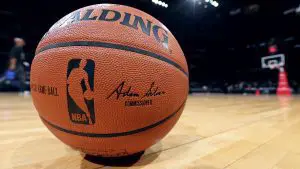When it comes to professional basketball, the NBA sets the standard for the size and dimensions of the basketball used during games. The size of the basketball is crucial, as it affects the way players handle, pass, and shoot the ball during gameplay. Knowing the specific size and dimensions of an NBA basketball can be helpful for aspiring players who want to train with the appropriate equipment or fans who want to better understand the game.
An NBA basketball measures 29.5 inches in circumference, which is also known as a size 7 basketball. This is the standard size used in all NBA games, as well as many high school and college leagues. The construction and materials of the basketball are also important factors since they can influence the ball’s performance. Players must train and compete with an optimal ball size and weight to ensure a fair and consistent playing experience.
Key Takeaways
- NBA basketballs measure 29.5 inches in circumference, or size 7
- Ball size and weight can impact gameplay and player performance
- The NBA’s standard size is widely used across high school, college, and professional leagues
NBA Basketball Size and Dimensions

Circumference
The NBA basketball, used by professional men’s basketball players, has a circumference of 29.5 inches. This specific size allows players to grip, dribble, pass, and shoot the ball comfortably during the game.
Diameter
In terms of diameter, the NBA basketball measures between 9.43 and 9.51 inches. This diameter facilitates the level of control needed for the players to execute consistent and accurate plays.
Weight
An NBA basketball weighs about 22 ounces, providing a suitable weight for the players to maintain control and power during shots and passes. This weight also ensures that the ball travels well when passing between team members.
Comparison to Other Basketball Sizes
There are variations in basketball sizes used across different leagues and levels:
- WNBA basketball: The Women’s National Basketball Association uses a ball with a maximum circumference of 29 inches and a diameter of 9.07 to 9.23 inches, slightly smaller than the standard NBA basketball.
- NCAA basketball: College and high school games use balls similar in size to NBA and WNBA basketballs, ensuring consistent play experience across leagues.
- Size 7 basketball: The NBA size is known as a size 7 basketball and is the standard for men’s basketball.
By knowing these differences in basketball sizes, you can better understand the specific requirements each league demands and how they cater to various levels of skill and competitiveness.
Knowing the specific size and dimensions of an NBA basketball can be helpful for aspiring players who want to train with the appropriate equipment or fans who want to better understand the game.
Materials and Construction
Leather Basketballs
When you think about an NBA basketball, the first thing that comes to mind is its leather exterior. The official NBA basketball is made from all-leather material, thanks to a partnership between Wilson and the Horween Leather Co.. This high-quality leather provides a great grip, which is essential for the players to perform at their best in the games.
The process of creating a leather basketball involves four key components: an internal bladder, a winding layer, a carcass layer, and the leather cover. The bladder is typically made of rubber and serves as the core of the ball, holding the air inside. The winding layer is made of nylon threads, creating a strong structure to support the carcass layer, which is made of synthetic material. Finally, the leather cover is applied as the exterior of the basketball.
Synthetic Material Basketballs
Aside from leather basketballs, there are also those made from synthetic materials. These basketballs are more affordable and are commonly used in recreational and youth leagues. Synthetic material basketballs are constructed with a combination of rubber, synthetic leather, and composite materials to provide a suitable grip for playing the game.
Synthetic leather basketballs, made of composite materials, resemble the feel and performance of genuine leather basketballs but come at a lower cost. On the other hand, rubber basketballs are the most affordable and durable option, making them ideal for outdoor play and practice sessions. The rubber exterior is quite resistant to wear and tear compared to its leather and synthetic leather counterparts.
In conclusion, while the official NBA basketball is made of leather, synthetic material basketballs provide additional options for players of different skill levels and budgets. Each type of basketball has its own benefits and drawbacks, but all are designed to offer a comfortable and enjoyable playing experience.
Basketball Court Specifications
NBA Court Dimensions
When it comes to the size of an NBA basketball court, you’ll find that it measures 94 feet long and 50 feet wide (28.65 m x 15.24 m). This standard allows consistency across all games in the National Basketball Association, ensuring a fair and level playing field for all teams.
Key Elements of the Court
On an NBA basketball court, there are several key elements that define the game and make it unique. Here’s a brief overview of some essential features:
- Basketball Hoop: The hoop, also known as the rim, has a diameter of 18 inches (45.72 cm) and is mounted 10 feet (3.05 m) above the ground. This height remains standard across all levels of basketball, providing a consistent challenge for players.
- Basketball Size: The official NBA basketball has a circumference of 29.5 inches (74.93 cm). This size allows for optimal grip and control during the game.
- Three-Point Arc: The three-point line forms an arc that is 23 feet, 9 inches (7.24 m) away from the center of the basket at the top of the arc and 22 feet (6.7 m) away at the corners. Shots made from beyond this line are worth three points.
- Free-Throw (Foul) Line: The free-throw line is situated 15 feet (4.57 m) from the front of the backboard. When shooting free throws, players must stand behind this line to earn one or two points, depending on the foul committed.
- Restricted Area: Also known as the “key” or “lane,” this area is a painted rectangle below the basket, measuring 16 feet (4.88 m) wide. Offensive players cannot remain in this area for more than three seconds, while defenders use this space to draw charging fouls.
- Center Circle: The center circle is used for jump ball situations at the beginning of the game and has a diameter of 12 feet (3.66 m). Players start the game by competing for possession of the ball within this circle.
By understanding the specifications of an NBA basketball court, you can appreciate the athletic skill and strategy required to excel in this high-level competition. Familiarizing yourself with these critical elements can also enhance your enjoyment when watching or playing the game.
FAQ
An NBA basketball measures 29.5 inches in circumference, or size 7. It has a diameter between 9.43 and 9.51 inches and weighs about 22 ounces.
The size and weight of an NBA basketball are crucial as they affect the way players handle, pass, and shoot the ball during gameplay. It allows for optimal grip and control, ensuring a fair and consistent playing experience.
Yes, there are variations in basketball sizes used across different leagues. The WNBA uses a slightly smaller basketball with a maximum circumference of 29 inches, while college and high school games use balls similar in size to the NBA.
NBA basketballs are made of high-quality leather. They consist of an internal bladder, a winding layer, a carcass layer, and the leather cover. Synthetic material basketballs made of rubber, synthetic leather, and composite materials are also available.
- What Size is Regular Printer Paper? Quick Guide for Paper Dimensions - June 18, 2023
- What Size is My Monitor: A Comprehensive Guide - June 18, 2023
- How Big is Italy Compared to the US? A Concise Comparison - June 16, 2023

